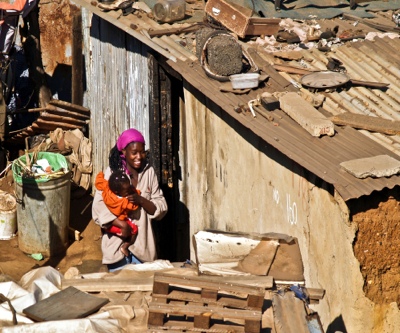
Thousands of people face evacuation from greater Johannesburg in the Gauteng province – the economic heartland of South Africa – due to toxic sludge from abandoned gold mines laced with high radiation levels.
Acid mine water, the result of groundwater flowing through underground shafts, is decanting from an old uranium mine and rising by half a metre a day beneath the city of 7 million people. Mass evacuation of informal settlements is one of several recommendations in a government-commissioned plan drafted in June to deal with 380 acid mine dumps – many of them radioactive.
Uranium is often mined as a byproduct of gold in South Africa and it is estimated that some 800 kilometres of tunnels exist underneath Gauteng left over from more than century of underground mining.
Business Times reported on Saturday a peer-reviewed report by Anthony Turton, a prominent South African water scientist, reveals that radiation levels at Tudor Shaft suggest that the country faces a localized environmental crisis that can be compared to Chernobyl.
The Mail & Guardian reported last week the acid mine drainage is coming back to burn the industry now. The mining companies have put together a R70 million ($9 million) project and appointed a cost-recovery company to solve the legacy problem and help provide extra potable water in the Gauteng province.
Johannesburg is one of the 40 largest metropolitan areas in the world, and is also the world’s largest city not situated on a river, lake, or coastline. South Africa accounted for 12% of the world’s gold production in 2005, though the nation had produced as much as 30% of world output as recently as 1993. Almost 50% of the world’s gold reserves are found in South Africa according to the US Geological Survey.
The Top Star mine dump, shown here, was constructed from 1899 to 1939, reaching a height of 50 meters and containing 5.1 million metric tons of chemically processed mine waste. In the early 1960s, Top Star was converted into a drive-in movie theater, which showed movies until 2006, when it was shut down by DRD Gold to extract latent gold in the mine waste. The mine dump’s dramatic height within Johannesburg’s urban core offered spectacular views of the Central Business District.
Image of unidentified woman and child in squatter camp in Soweto, Johannesburg, South Africa by Brians / Shutterstock.com.
8 Comments
Eric
U grade in the Witswaterstrand is about 200 parts per million. Very low grade and only mined as a by-product. Would not be even close to economic by itself. I find it very hard to believe that rocks with about 200 ppm U could produce dangerously radioactive water. “Compared to Chernobyl” ?!? What does a reactor have in common with a mine with a low grade uranium by-product? Not much, I would say.
Wolfgang
Wolf
cheers Eric, have another drink of it
Wjoughin
This is an example of very bad journalism. comparing to Chernobyl?????
Trevor
This is very irresponsible journalism to claim that this is like Chernobyl in any way. This writer needs their credentials taken away and demoted to mail room for trying to sensationalize the story like that.
Neil
I would love to find out more, and not just one persons hearsay. I am planning a trip there and no one gos on holidays to Chernobyl!
MINING.com Editors
For those interested to find out more, here are links to other articles about AMD:
Sky News Oct 2010: http://bit.ly/v0AZEc
Mineweb May 2011: http://bit.ly/msSjOc
SABC 50/50: Video documentary and panel discussion:
Part 1: http://www.youtube.com/watch?v=m6IDiXgGB9g
Part 2: http://www.youtube.com/watch?v=KmqnWImJ6Aw
BusinessLive Sep 2011: http://bit.ly/o72LMR
Anthony Turton, who first made the Chernobyl claims more than a year ago: http://www.anthonyturton.com/
Eric
Whoever first made the comparision to Chernobyl is guilty of irresponsible fear-mongering and sensationalism. There is no comparison between a mine with a U by-product and a nuclear reactor. A melting down nuclear reactor can release many dangerous fission products such as Cs-137 and I-131. This is simply not possible at a mine where the only nuclear reactions going on are the natural, slow decay of U.
Judith Machin Crimmins
And our Congress wants to open up hundreds of mining claims in our Grand Canyon…including gold mining and uranium mining…Gosar, Schweikert and Flake all are pushing this and with a Republicn Congress it will probably happen and take a Presidential veto to stop it.